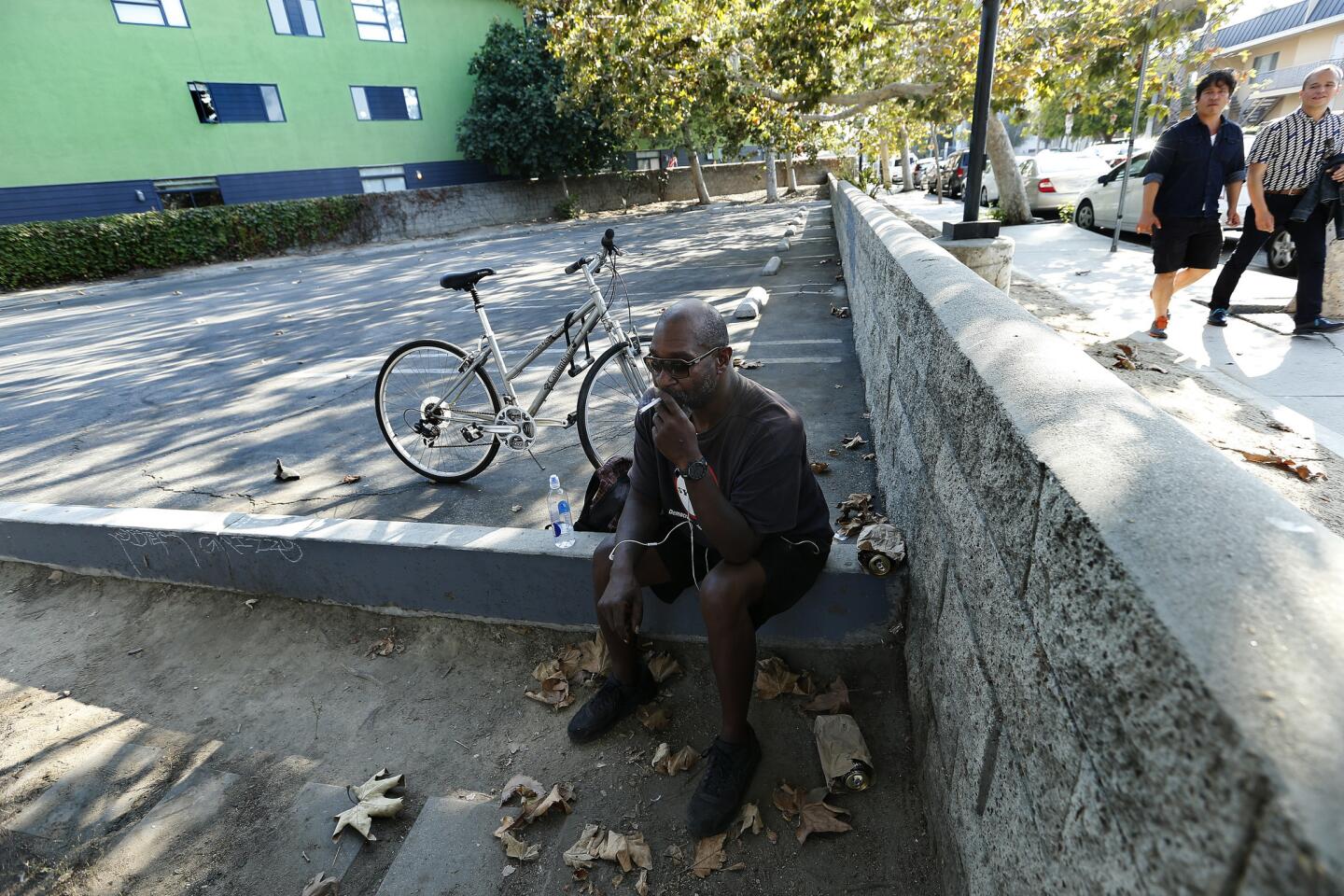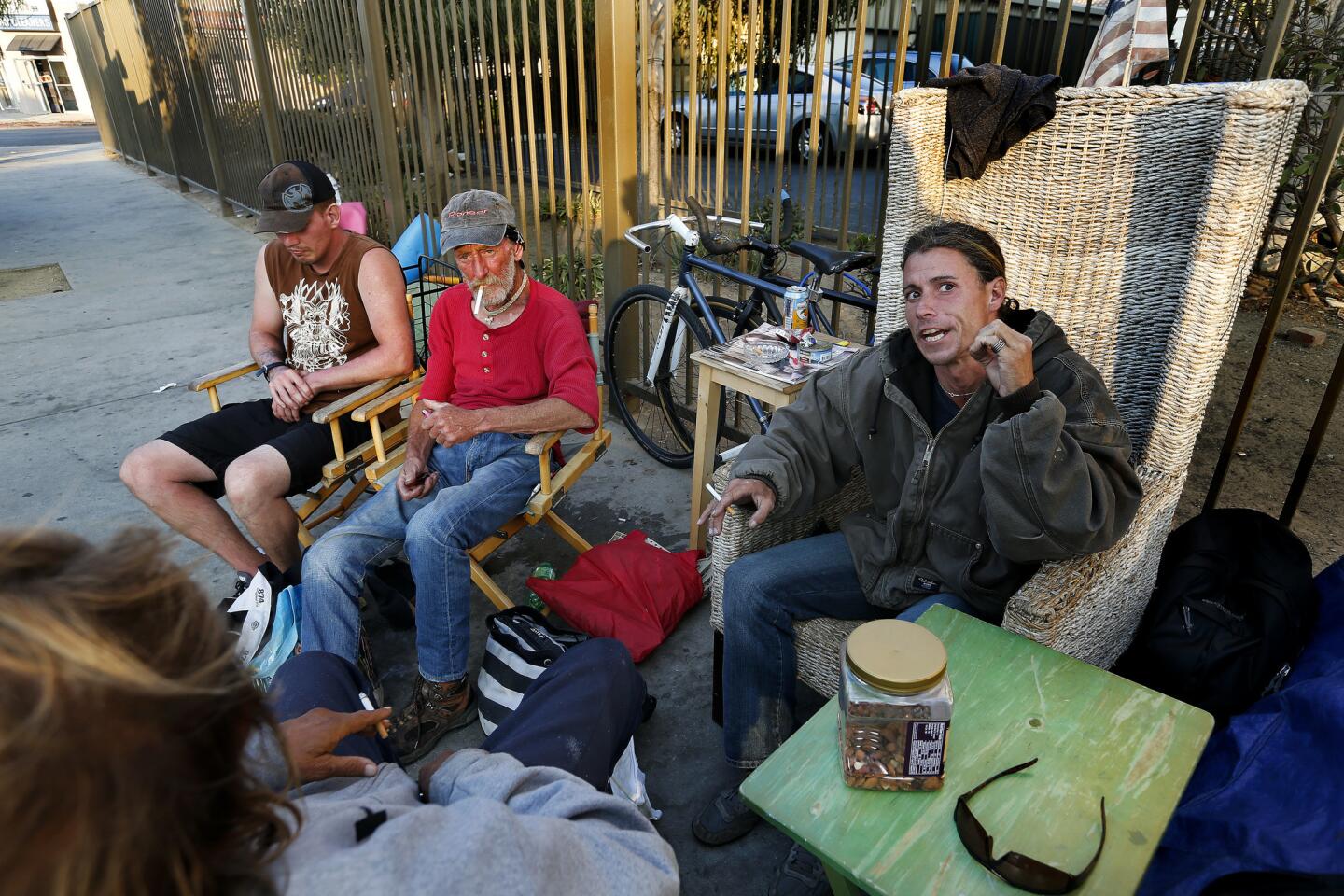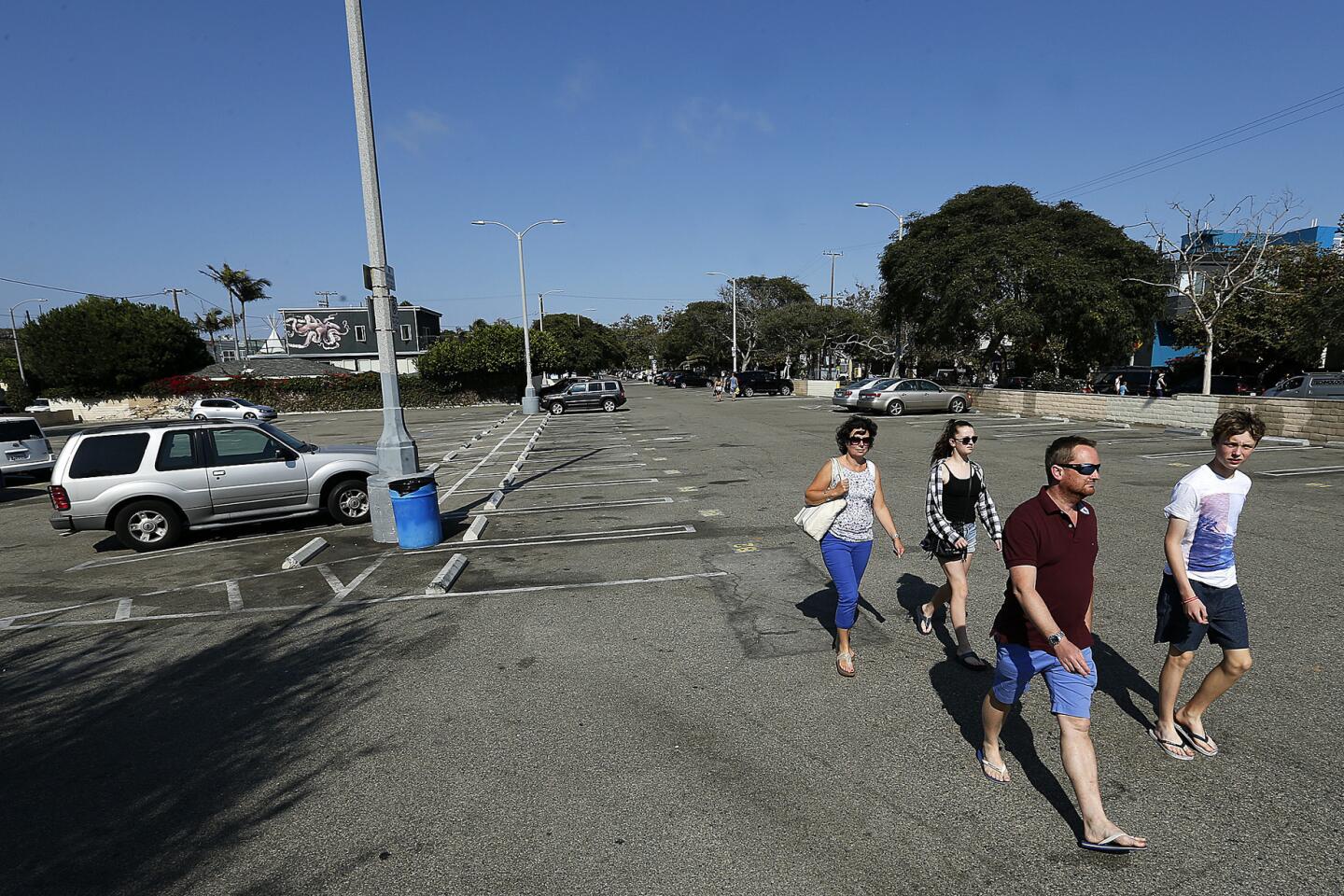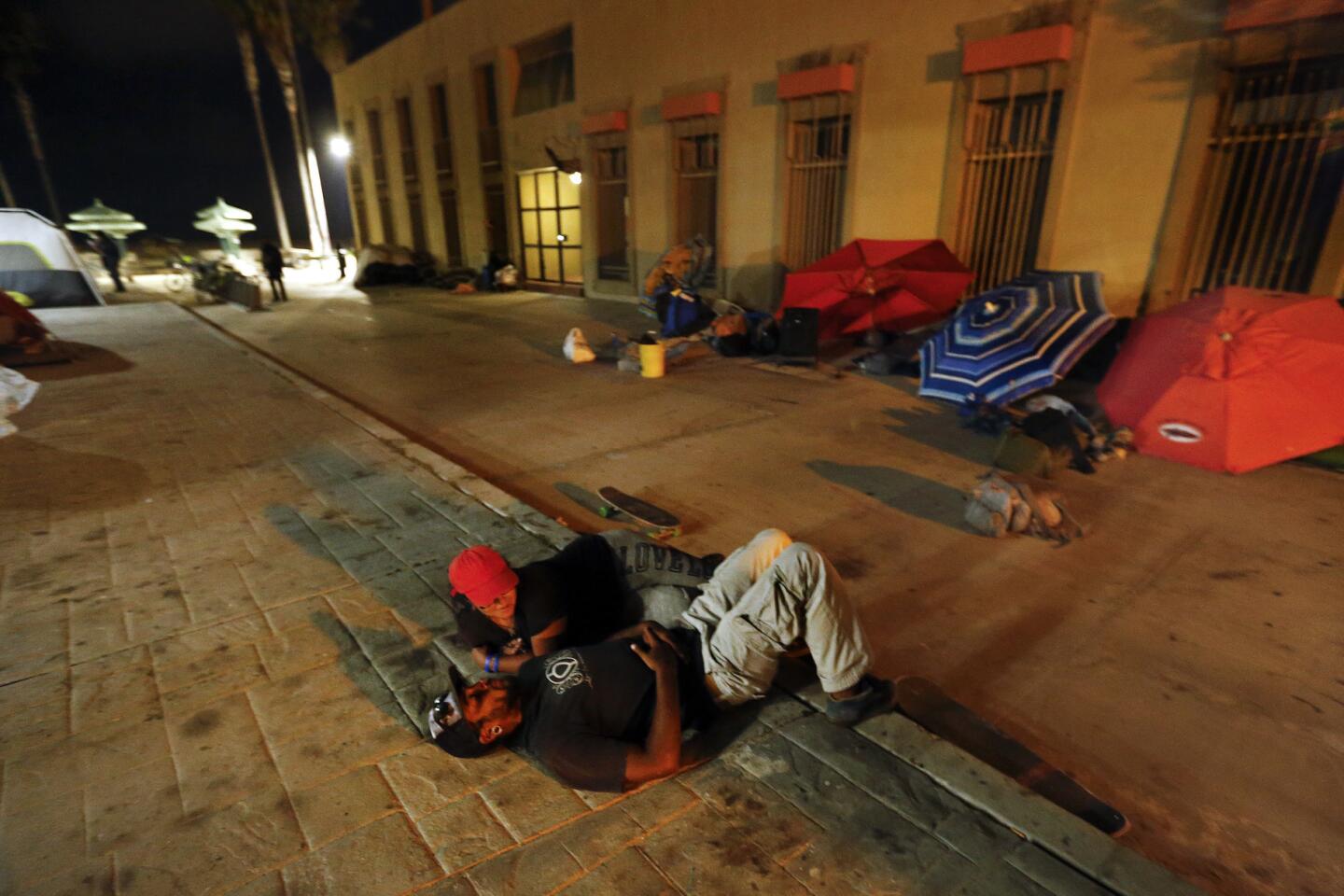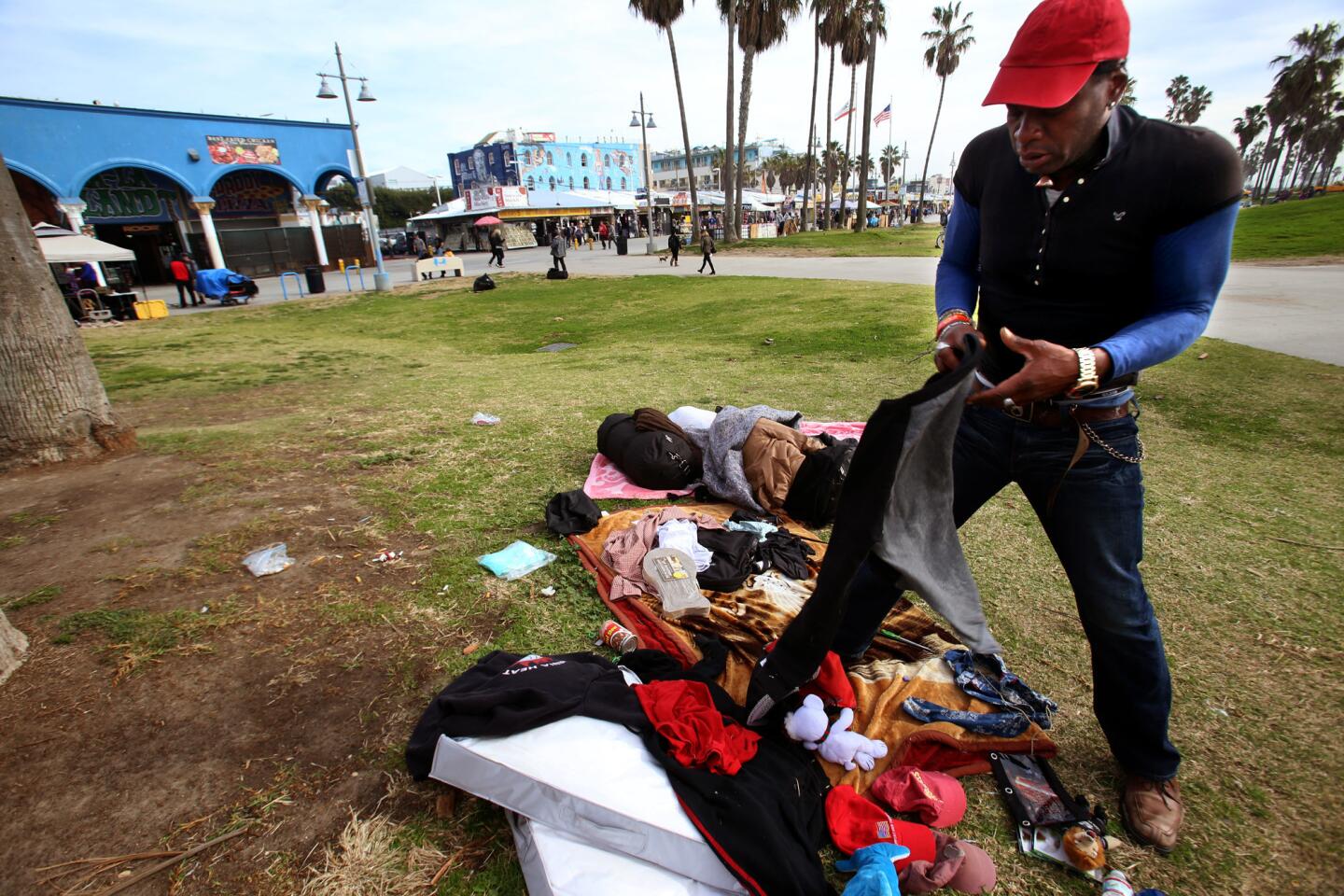Fears mount over a homeless plan that residents say will ‘end Venice as we know it’
- Share via
John Moore, a shaggy-haired, full-bearded surfer, Venice resident and launcher of “ethically minded” brands and fashion lines, said he loves the history, diversity and creativity of his neighborhood.
His family’s lifestyle — crafting, tandem skateboarding and eating on pillows in the backyard — has been celebrated as “haute bohemian” in online video and photo spreads. But Moore, 42, who came up with the name for Abercrombie & Fitch’s Hollister brand, draws the line at a proposal to house homeless people blocks from his property.
“I will help you come up with a solution that is not putting people in my alley, in my frontyard, that could potentially devalue my home and put me and my children in jeopardy,” Moore told City Councilman Mike Bonin at a rancorous community meeting last month.
Moore is among the many residents at loggerheads over Bonin’s detailed strategy to curb the homeless population in Venice, a beach community that is very much in flux.
Once a haven for struggling artists, Venice is a stark example of the nation’s gulf between the haves and have-nots — a place where housing costs have soared with the presence of Google, Snapchat and highly paid tech and entertainment professionals. Median incomes shot up 20% in the last five years, $1.7 billion in residential property changed hands and the going rate for a mid-level, one-bedroom apartment is $4,400, according to Trulia, a real estate site.
A new caste of coders, brand ambassadors and digital experience designers has taken up the creative mantle of edgy artists like poet Charles Bukowski and the Doors’ Jim Morrison. The funky antique shops and bodegas of Abbot Kinney Boulevard and Rose Avenue have given way to “luxury performance makeup” and vegan offerings, while bungalows and duplexes are being replaced by houses looming out to the lot line.
Meanwhile, most of Venice’s 1,000 homeless people — one of the city’s largest concentrations outside skid row — sleep in tents and bedrolls along alleys and sidewalks.
“Venice is ground zero of the city’s gentrification,” said City Administrative Officer Miguel A. Santana. “Venice is changing, and they’re fearful, and it’s a legitimate fear.”
Bonin and commercial property owners want to introduce private security patrols and cleanup crews on the boardwalk and in other homeless hot spots. Homeless advocates back Bonin’s call for services such as housing, bathrooms, showers and a storage center.
The proposals await City Council approval, funding or both. While some residents say the patrols will fuel gentrification and bully homeless people, others argue that the services will turn Venice into a homeless “hub.” At the meeting, both camps depicted the plan as a battleground over the future of Venice.
Becky Dennison of Venice Community Housing urged the city not to push out low-income or minority residents “or we will lose the character of Venice and the flavor of Venice that has made this community amazing.”
Resident Daryl Barnett assailed the storage proposal, saying Bonin’s “plan will end Venice as we know it.”
Bonin, a 49-year-old Harvard graduate, said he sees the homelessness issue from both sides.
A longtime Venice resident who now lives in Mar Vista, Bonin said his former home was broken into and his street had people sleeping in RVs. But the councilman added that as a former alcohol and drug addict — he has been sober for 22 years — he understands why some homeless people resist shelters and services.
With homelessness at crisis levels, Bonin said the city cannot continue to dodge controversy.
“The easiest thing for me is to defer a decision … but I also know it would be unconscionable to me not to make a decision,” Bonin said at last month’s public meeting, one of a series of events he has held to explain his plans.
The boardwalk is one of the last bastions of Venice’s racial diversity and pirate spirit. By day, it’s a roiling carnival of panhandlers, skaters, homeless people and aerosol artists. But after dark, it becomes a ghost town as the homeless tents go up and police SUVs crisscross the sand enforcing curfews.
In August, the City Council approved a new business improvement district to run boardwalk patrols. During the hearing, City Council President Herb Wesson cut off public testimony, prompting a complaint from a legal aid attorney. The city attorney recommended a second balloting, which is now underway.
Ira Koslow, president of the Venice Neighborhood Council, said some neighbors fear the patrols are part of a push to make the boardwalk into a Miami Beach-style dining and entertainment strip.
A glassed-in dinner house and bar on the boardwalk is planned. City Atty. Mike Feuer alleged in a June lawsuit that two of the improvement district organizers, Carl Lambert and William Andrew Layman, had illegally converted boardwalk rentals to hotels. Lambert and Layman denied they acted illegally.
In nearby residential areas, bar patrons could be more disruptive than homeless people, who generally stick to the business district, Koslow said.
“The boardwalk is the boardwalk, it doesn’t need to be turned into the Third Street Promenade,” said attorney and lifetime resident Erin Darling, referring to Santa Monica’s manicured shopping district.
Bonin said there were no plans to sanitize the boardwalk. “It’s the heart and soul of Venice, it always has been and should be very different than Third Street,” he said.
The flashpoint at the community meeting was a homeless storage facility Bonin has proposed at the site of the now-vacant Westminster Senior Center.
The neighborhood council opposed the $303,000 pilot project, and residents filed suit earlier this month, saying it would “cause severe harm to the surrounding community,” including schoolchildren.
“Venice is already so heavily impacted,” said resident Katrina Glusac, one of the plaintiffs on the lawsuit. “I’ve talked to so many homeless people, six months into their sobriety, who say, ‘The best thing that happened to me was changing my peer group.’ The boardwalk is about drugs, it’s not about homelessness.”
Bonin said he would explore mobile storage or other locations, but added that without Venice storage, the city could not keep the streets clean or free homeless people from having to guard their possessions.
“Consistently and repeatedly the courts have said you do not have the authority to enforce your rules and regulations until you do a better job of providing for your homeless people,” Bonin said at the community meeting, to scattered jeers.
Perhaps Bonin’s boldest proposal is to set aside premium coastal land for homeless housing. The Thatcher maintenance yard and the Dell-Pacific parking lot in Venice are on a list of 12 surplus properties the city is exploring to develop or sell for homeless housing; Venice residents do not want it near their homes.
“I think you can do more in a different location and faster,“ resident Kip Pardue said at the meeting.
Attorney Gloria Dabbs-Mann, a Venice native and one of only two African American speakers at the meeting, urged Bonin to preserve housing in Venice for everyone.
“I grew up here. There were black people, white people, brown people, Native Americans — everybody lived here and it made a me a better person,” Dabbs-Mann said.
“There are several of us who believe it’s important to have affordable housing in all parts of the city,” Bonin said. “l can guarantee you there will not be policy adopted that we should sell all property in wealthy areas and build in poor areas.”
Eric Harris, 49, has lived in the streets of Venice for 14 years. Resting on his bicycle in the half-empty parking lot where homeless housing is envisioned, Harris said he’ll take housing anywhere he can get it. But it won’t be in Venice, he predicted.
“The Abbot Kinney crowd doesn’t want housing over here,” he said. “It’s too close to the beach.”
Twitter: @geholland
ALSO
How the federal government’s bribery case against 2 brothers unraveled
Many UC workers struggle to feed themselves and their families, study shows
More to Read
Sign up for Essential California
The most important California stories and recommendations in your inbox every morning.
You may occasionally receive promotional content from the Los Angeles Times.
